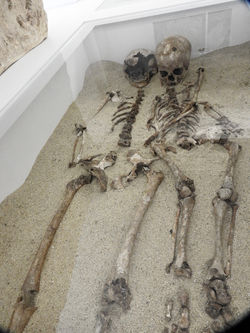
If you like ancient history, Sicily is not to be missed. Here, you can stroll through a valley of eight Greek temples, gaze upon a bronze Dancing Satyr raised up from the sea bed, visit a once thriving villa resplendent with mosaics, compare Greek, Roman, and Baroque architecture, learn about the ages old art of producing and refining salt from the sea, or climb winding steps to view an impressive Greco-Roman theater.
Whew...
Villa Romana del Casale was built as a hunting lodge in the mid 4th c. CE and buried by a landslide in the 12th c. Rediscovered in the 19th c. and excavated in the 20th, it is known for its well preserved and exquisite mosaics. It provides a colorful and detailed glimpse into 4th c life with depictions of wild animal scenes from Africa, mythological figures, bikini clad women, children playing, and even a little romance. Amazing...

Beautiful mosaic floors upon floors
 |  |  |  |  |  |
|---|---|---|---|---|---|
 |  |  |  |
-
Valley of the Temples, near Agrigento, is home to eight Greek temples, built between 510 and 430c BCE.
-
Greco-Roman Theater at Taormina was built in the 3rd c BCE. It hosted the G7 summit in 2017.
-
Between rolling hills and vineyards, a 5th c BCE Greek Doric temple sits near Segesta, a major trading center of the Elymians, early inhabitants of Sicily. It is one of the most well preserved Greek temples in the world.
-
Ruins of a Phoenician settlement, some 2,700 years old, are found on the small island of Mothya (Mozia). Little remains, but the small museum houses a life size marble statue, referred to as the Youth of Mozia or the Charioteer, as well as many artifacts found on the island.

Before and after they mopped the floors - quite a difference.


The bronze Dancing Satyr of Mazara del Vallo was caught in the fishing net of the Captain Ciccio in 1998. It is believed to be from the 4th c BCE and of Greek origin. It was beautifully restored.
The museums and archaeological sites were fantastic!










Before and after they mopped

The National Museum in Reggio Di Calabria has ancient bronze statues and heads as well as other centuries old sculptures, pottery, small figurines, tools, jewelry and more.
 |  |  |  |  |  |
|---|---|---|---|---|---|
 |  |  |  |  |  |
 |  |  |  |  |  |
 |  |  |  |  |

An ancient Greek settlement known as Poseidonia was founded about 600 BCE. By 273 BCE it was controlled by the Romans and known as Paestum. It is home to 3 well preserved Doric Greek temples dedicated to Neptune, Hera, and Athena. In the middle of the site are remnants of buildings and homes, a Roman amphitheater and forum, Roman baths, roads, and surrounded by the still standing city walls.
Paestum, Calabria
Ancient Calabria
A fascinating find at Paestum is the fresco decorated
Tomb of the Diver or Tomba del tuffatore
The link goes to a YouTube video describing the tomb and providing an explanation of the meaning of the frescoes found on the interior walls - vey interesting


 |  |  |  |  |  |
|---|---|---|---|---|---|
 |  |  |  |  |  |
 |
All four sides have scenes from a symposium, while the top slab shows the diver
